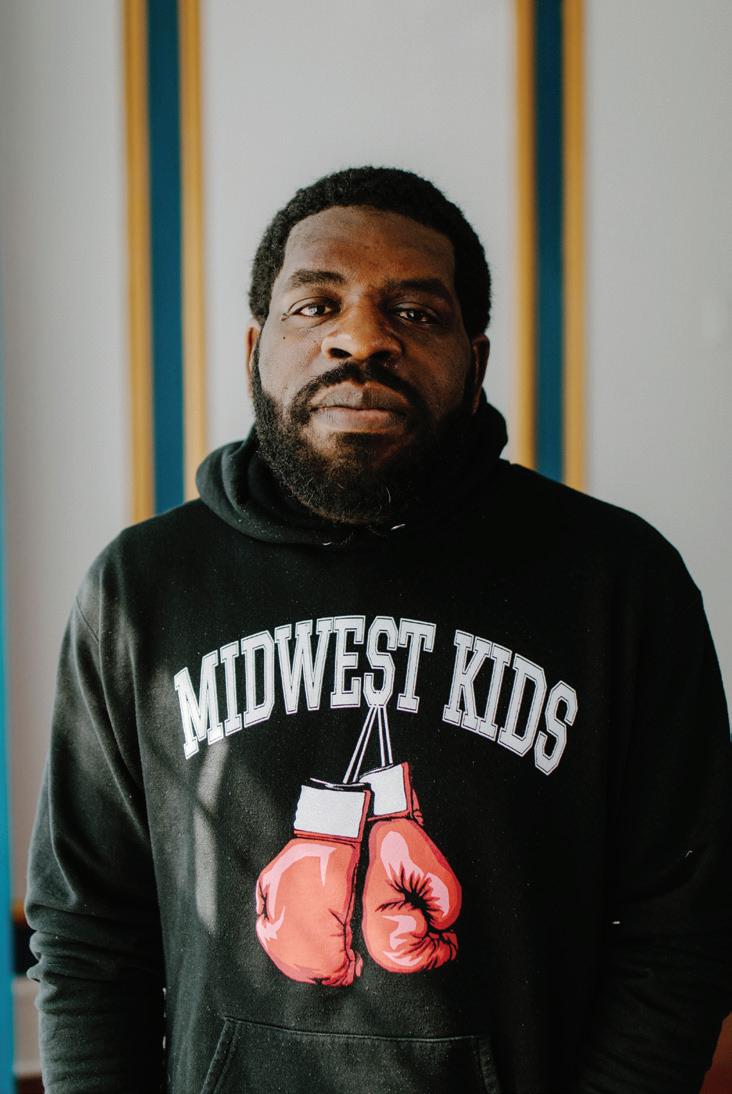
9 minute read
Datebook
Interior of the Cozad-Bates House Interpretive Center
Road to Dating back to 1853, the Cozad-Bates House stands as the last remaining pre-Civil War home in Cleveland’s University Circle Hope neighborhood. In September, the restored home opened to the public to teach visitors about the city’s history of antislavery activism and its role as part of the Underground Railroad. The Cozad-Bates Andrew Cozad, whose family settled in the area in the early House Interpretive Center tells the story of Cleveland’s abolitionist 19th century, built the home for his son, Justus. The Cozads and a neighboring family, the Fords, as well as other locals helped guide formerly enslaved people on their journey to freedom in Canada. The code name for Cleveland along the history and those Underground Railroad was “Hope.” who helped freedom “We don’t know for sure if the house was a stop on the Unseekers along the derground Railroad,” says Elise Yablonsky, planning director Underground Railroad. at University Circle Inc., which owns the home, “but it is the last remaining fabric from that time period, and some Cozad family members, as well as families around the Cozads, were antislavery activists. We wanted to dedicate space to bringing light to this story.”
The home served as a boarding house in the early 1900s and remained one for years before falling into disrepair. In 2006, the home’s owner, University Hospitals, donated it to University Circle Inc., which led a $2 million effort to protect and adapt the property for reuse. It included opening the historic portions of the home and the front lawn to the public as an interpretive center, with help from partners Restore Cleveland Hope and Western Reserve Historical Society.
The exhibition presented inside, “Finding Hope: Cleveland and the Underground Railroad at the Cozad-Bates House,” details who the Cozads and Fords were, how Cleveland abolitionists and local courts responded to runaway slaves and much more. The home’s front lawn is filled with educational touches. Medicinal and edible plants in the landscaping reflect the hope that land could provide freedom seekers, while the sidewalk features insightful quotes and the constellations the Big Dipper and the Little Dipper. The latter contains the North Star, which served as a guide in the night sky for those escaping slavery.
“The center shares a history that is too little known in Cleveland,” Yablonsky says. “[It] celebrates and honors freedom seekers in what was once East Cleveland Township.” — Rebecca Vernak
Open Saturdays noon–4 p.m.; 11508 Mayfield Rd., Cleveland 44106, 216/791-3900, universitycircle.org/cozad
OHIO FINDS
FASCINATING OBJECTS FROM OUR PAST

19TH-CENTURY LADLE & FORK Blacksmith-made hearth utensils marked “Cy. Crites”
Among the most important skilled tradesmen of the 18th and 19th centuries, blacksmiths made everything from horseshoes to hinges. A smithy was vital, but his often-unmarked utilitarian products can be overlooked in the jumble of antique ironwork.
Even signed examples can lead to mysteries. That’s the case with a scant number of objects signed “Cy. Crites,” a blacksmith who is believed to have worked in Allen County. Two examples are a 19 1/2inch, two-tine fork dated 1841 and a 21 1/2-inch ladle dated 1848.
It’s likely “Cy. Crites” was the son of John Daniel and Maria Catherine Crites, who moved to Ohio from Pennsylvania. The couple had 13 children, including Cyrus Crites. Although census records indicate Cyrus was a farmer, it’s possible he was skilled enough to have made the utensils and tools marked “Cy. Crites.” However, several of his brothers were also blacksmiths, including Charles Cyrus Crites, also a potential source of the utensils. No matter the maker, any blacksmith-made item from the family is a scarce find. — Richard “Jeff” Jeffers
$1,750 (ladle) $1,375 (fork)
SOLD AT AUCTION
Richard Jeffers is the owner of Garth’s Auctioneers & Appraisers in Columbus.

Hungry for More Ohio Magazine?
Visit OhioMagazine.com/recipes for new dishes and reader favorites.






Way with Words
Poet and essayist Hanif Abdurraqib shares how Columbus shaped his writing and talks about staying focused in the face of success.
Ask Hanif Abdurraqib’s favorite spot in Columbus, where he still lives, and get a day tour: the Park of Roses, Franklin Park and Resch’s Bakery on the city’s east side, where he grew up. He runs a music website (68to05.com) and serves as an editor-at-large for the publisher Tin House, In September, Columbus-based poet and essayist Hanif Abdurraqib received a but is eager to start a basketball book and prestigious MacArthur Foundation grant. pursue documentary filmmaking.
“I’m mostly just trying to stumble my way forward and see what’s next without getting so excited about everything that I overextend myself,” he says.
This strategy has turned the poet, essayist and cultural critic into a literary star. His 2017 essay collection, They Can’t Kill Us Until They Kill Us, was named a book of the year by Buzzfeed, Esquire and Oprah Magazine. In March, A Little Devil in America: Notes in Praise of Black Performance was a National Book Award finalist. In September, he received a prestigious MacArthur Foundation “Genius Grant.” We talked with Abdurraqib about his hometown, writing and staying humble. — Pete Croatto
What role did Ohio play in you becoming a writer?
A: Columbus specifically played a big role. That’s where I learned how to write. I cut my teeth, blending criticism and poetry at poetry slams in the city, like Writers’ Block and Writing Wrongs. That’s where I really learned how to do the writing I do now. And I shaped my writing voice and [learned] how to write and make low-stakes mistakes and really learn from that. Columbus really shaped the way that I write and think about things.
When did you realize that your writing resonated with people?
A: I’m still kind of in awe of that and disbelief of that. It’s one of those things that I don’t ever think about until people come up to me. I always appreciate that. I know a lot of writers have that big ‘a-ha’ moment, but truly I keep my head down and work. Again, it’s not out of a lack of gratitude to the folks who were moved by my work. If I began to think of it on a granular level, it would make it a bit harder for me to keep my head down and keep working.
How do you maintain that attitude when you win a MacArthur grant?
A: That doesn’t really change the work. The work is what brought me here and the work has to continue. I’m not much of a celebratory person. I’m a person that’s steeped in gratitude. With gratitude, I can be propelled toward more work. The fact that I get to write and pursue my curiosity in the way that I do is a bit miraculous. That’s what kind of propels me back to the work and keeps my head down. I just find real pleasure in the work; I find real pleasure in unearthing the delights of the world that I did not know before.

For more information, visit abdurraqib.com.
DATEBOOK
Night Lights
Nov. 19–Dec. 31, Toledo
Atradition since 1986, Toledo Zoo & Aquarium’s Lights Before Christmas offers the chance to walk through a holiday experience with more than 1 million lights and over 200 illuminated animal images. Enjoy the outdoor exhibits, then warm up inside or with a cup of hot chocolate. Concessions include holiday food and beverage at the Yuletide Food & Spirits tent. Enjoy soups, appetizers, desserts, holiday cocktails and seasonal beers. Get a photo with Santa at the North Star Trading Post gift shop, head down the ice slide or take a ride on the African carousel and the Holly Jolly Express Train. 2 Hippo Way, Toledo 43609, 419/385-5721, toledozoo.org/lights

COURTESY OF TOLEDO ZOO & AQUARIUM Knowing Van Gogh: “Through Vincent’s Eyes: Van Gogh and His Sources” delves into the artists that inspired one of the world’s most famous painters. Calendar of Events: Your holiday plans start here. Browse our guide to shows, festivals and other happenings scheduled between now and the end of December.
theater
A Christmas Carol

Nov. 26–Dec. 23: Cleveland, greatlakestheater.org
Since its publication in 1843, Charles Dickens’ A Christmas Carol has persisted as one of the most beloved and adapted holiday classics of all time. Although audiences are familiar with the story, the annual production staged by Cleveland’s Great Lakes Theater puts an original spin on the tale.
This version of the play opens as the mother of the Cleaveland family prepares to read A Christmas Carol to her children gathered around her. The youngest child imagines the tale as it is being read, and the play is presented from his point of view.
“We watch the stage transform into Scrooge’s counting house, taking us back in time to Dickens’ day,” explains Charles Fee, producing artistic director of Great Lakes Theater. “We wanted to create the suggestion that we’re not that distant from Dickens’ original themes. This is a tale from long ago, but are we really that different now?”
Since its debut in 1989, Great Lakes Theater’s “A Christmas Carol” has grown into a tradition for both the theater company and Playhouse Square, where the play is staged each holiday season.
The production’s family-friendly telling and run time of under two hours have cemented it as a local favorite. Fee says sharing that experience together, after the show was not able to be staged in 2020, has taken on added significance this year.
“This season, we want [people] to remember what it feels like to come together as a community, sharing A Christmas Carol’s experience of redemption, of forgiveness, and of love.” Fee says. “There’s nothing like being with other people, as we all know now more than ever. Community is at the heart of this play.” — Sarah Druhan
dance
BalletMet’s The Nutcracker
Dec. 10–26: Columbus Journey into the realm of fantasy and back over the course of an evening, as this classic tale set to Tchaikovsky’s timeless score makes its return to the Ohio Theatre stage. Bring the family and be transported by this central Ohio holiday tradition. balletmet.org
theater Wicked
Nov. 17–Dec. 5: Cincinnati The “untold true story” of the witches of Oz marks the return of Broadway to the Aronoff Center. Through a cast of compelling characters and a beloved soundtrack, this spellbinding musical explores the land over the rainbow from a different perspective. cincinnatiarts.org

exhibit
Age of Armor
Beginning Nov. 6: Toledo
This exhibition showcasing the Worcester Art Museum’s Higgins Armory Collection explores the roles armor has played in the military, technological and cultural life of societies throughout history. Featuring pieces from one of the largest collections of its kind, armor in the exhibition ranges from the stylish pieces of ancient Greece to the armor of Europe during the Middle Ages to the medieval-inspired collectibles of the late 19th and 20th centuries. toledomuseum.org











